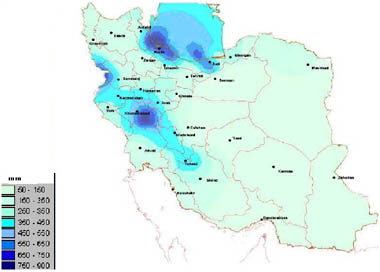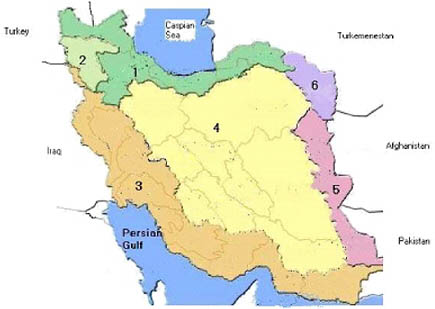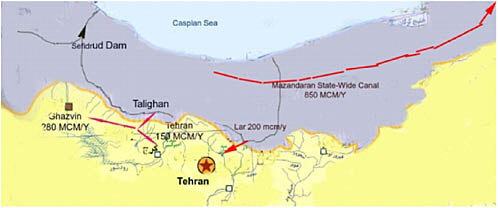Interbasin Water Transfers in Iran
Ahmad Abrishamchi and Massoud Tajrishy
ABSTRACT
Iran is an arid and semiarid country with scarce and sensitive water resources. The increasing demand for water has caused an alarming decrease in annual per capita renewable water resources, currently estimated to be about 2,000 m3 for a population of around 65 million. With the current trend in population growth, the per capita water available is predicted to decrease to less than 1,000 m3 by the year 2025, which will put Iran in the category of countries with chronic water scarcity. As available water resources are unevenly distributed in terms of both time and space, water resources in many areas are already under pressure.
Over the past two decades, much effort has been expended and great strides have been made in the development and exploitation of water resources for various uses. Primarily these efforts have been aimed at maximizing water supply to meet increasing demands. At the same time, enough attention has not been paid to integrating other approaches in which emphasis is placed on managing demand and saving water through sound water consumption practices.
The uneven distribution of water across the country, on the one hand, and the expansion of population centers as well as developments in agricultural and industrial activities, on the other, has led to the present shortage of water for urban and domestic uses. Acting upon a traditional approach to water management, water managers at both local and national levels find water transfer from humid zones to arid zones to be the only option to satisfy demand. Each year proposals are presented to the government for new interbasin water transfer (IBWT) projects, which are normally backed by political pressure. These efforts occur even while efficient and effective use is not being made of the available
water resources. In addition, water consumption in the urban, agricultural, and industrial sectors is not satisfactory. Although the water transfer projects have helped to reduce the intensity of water shortage in the receiving areas, a holistic and integrated approach has not been observed in planning for these projects.
Recent years have witnessed a renewed emphasis on integrated management of water resources, on the basis of which a new comprehensive water act and water management system is being developed. Increased awareness among water managers of the advantages of integrated water resource management and increased concerns about the possible adverse effects of IBWT projects have led to more careful examination and more in-depth study of new proposals.
This paper will present the current water resources situation and the trend in water consumption in Iran, and outline the new policies and strategies adopted by the water sector. It will also review and discuss information on several large interbasin water transfer projects, some implemented and some proposed for implementation. The paper will conclude with results and recommendations.
INTRODUCTION
Water is a vital natural resource for human beings and other forms of life; it is crucial to food production, serves as an input to many economic activities, and possesses spiritual and psychological values beyond its strictly utilitarian functions.
In semiarid and arid regions, limited water is available for beneficial uses. Iran is an arid country with an average annual precipitation of about 250 mm; less than one-third of the world average. Renewable water resources in Iran have been estimated to be 130,000 mm3 per year, which may be considered the long-term average of national water assets. The increasing water demand has caused an alarming decrease in per capita renewable water available. The annual per capita water as a general index of the water resources status used to be about 7,000 m3 in 1956 when the population was only 19 million. At present, with a population that has grown to about 65 million, the index is estimated to be about 2,000 m3. With the increasing trend in population growth, it is predicted to sink further, to below 1,000 m3 in the year 2025. These figures clearly show that our future generations are to face a serious water shortage during the coming decades. Pollution of water resources due to human activities makes this situation even worse.
Substantial achievements have been made during the last two decades in utilizing water resources for irrigation, domestic and industrial water supply, and hydropower generation. Due to the present increase in water demand by an increasing population, as well as the economic status and desire for higher standards of living by the public, the conflicts of water supply and water demand are gradually getting more serious so that the available water must be shared among different regions in the country for different uses. In most areas, local water resources have already been tapped, while demand remains beyond the capacity of existing water resources. Bridging the present and future gaps between demand
and supply will require tremendous efforts to develop various supply enhancements and demand management options, among which construction of new dams on the remaining unexploited sites and interbasin water transfer (IBWT) appear to water managers to be promising options. A number of IBWT schemes have accordingly been implemented or proposed in order to divert water mainly from northeastern basins into central arid regions.
Over the past few decades, IBWT projects have aroused much controversy and debate in the world and have drawn the attention of interest groups and scientists concerned with the protection of the environment and the subsequent social disruption caused by such schemes. In complex issues such as water management, where the problems and solutions differ in each and every case, the best way to understand and develop procedures for reasonable solutions is through examples. Hence, it is the aim of this paper to review some IBWT projects in Iran (though not in technical detail) and their assessment in the context of sustainable water management. In the first part of this paper, the basic concepts of IBWT and the assessment criteria are presented. These are followed by an overview of water resources and water use as well as the National Water Policy and Strategy and IBWT practices. Finally, conclusions and some recommendations are put forth.
INTERBASIN WATER TRANSFER
Interbasin water transfer is a response to a distribution of human population and related activities that differs from the spatial distribution of water resources. In arid and semiarid regions, IBWT has a long history as a means of addressing water scarcity in one region by transporting additional supplies from regions where water is relatively more abundant.
Three conditions are generally identified as necessitating water transfer systems as follows:
-
Local hydrologic conditions limit the availability of water resources;
-
Local centers of demand cannot be supplied by local resources in support of continuing urban development;
-
Local water supply conditions need improvement because of depletion and pollution of local water resources.
Interbasin water transfer is a technical (structural) tool consisting of the sharing of water resources between a receiving basin and an area of origin as the donor area. Prerequisites for successful cooperation between the receiving and the donor areas must be a shared management expected to promote sustainability, observation of common ethical values, production of benefits to both areas, and administration by suitable institutions. An unsustainable situation can be seen as the driving force for interbasin water sharing. Such an unsuitable situation happens
where lack of water security and shortages reduce the quality of life, economic development, and social progress. The objective in water sharing is the betterment of living standards and social welfare. Water transfer must not be associated with unwanted and adverse effects on sustainable water management in the donor basin through environmental, social, and cultural degradation.
Large hydraulic structures such as tunnels, canals, pipes, dams, and pumping stations are commonly required in the implementation of IBWT projects. These projects also involve costly infrastructural solutions in water management. One argument often raised against infrastructural solutions is that initiatives must be directed toward reducing water wastage before any efforts are made to justify costly investments that are associated with intervening in the natural hydrologic cycle.
CRITERIA FOR EVALUATION
Reducing water shortages that are serious hindrances to the sustained development of regions creates a significant advantage of IBWT. The disadvantage, however, is that transfer may entail restrictions on future development of the donor area along with other negative effects. It follows, then, that each IBWT proposal must be thoroughly evaluated in order to establish whether or not the project is justified; in certain cases, such proposals may be totally prohibited. The following five criteria to be used in justifying or rejecting IBWT projects are proposed by W.E. Cox (Cox, 1999):
Economic Productivity Impacts
Criteria 1 and 2 involve impacts to economic productivity in both the receiving area and donor area of the proposed IBWT project:
Criterion 1: The area of delivery must face a substantial deficit in meeting present or projected future water demands after consideration is given to alternative water supply sources and all reasonable measures for reducing water demand.
Criterion 2: The future development of the area of origin must not be substantially constrained by water scarcity; however, consideration of a transfer that could constrain future development of the area of origin may be appropriate if the area of delivery compensates the area of origin for productivity losses.
Environmental Quality Impacts
Criterion 3: A comprehensive environmental impact assessment must indicate a reasonable degree of certainty that the proposed IBWT project will not substantially degrade environmental quality within the area of origin or area of delivery; however, transfer may be justified where compensation to offset environmental injury is provided.
Sociocultural Impacts
Criterion 4: A comprehensive assessment of sociocultural impacts must indicate a reasonable degree of certainty that the proposed IBWT project will not cause substantial sociocultural disruption in the area of origin or area of water delivery; however, transfer may be justified where compensation to offset potential sociocultural losses is provided.
Benefit Distribution Considerations
Criterion 5: The net benefits from transfer must be shared equitably between the area of transfer origin and the area of water delivery.
WATER RESOURCES AND USES IN IRAN
Iran occupies an area of 1,648,000 km2, which is 1.2 percent of the earth’s total area. Climatologically, Iran is located in an arid and semiarid zone with an average annual precipitation of around 250 mm, which is about 34 percent of the average annual precipitation in Asia, or about 30 percent of the average annual precipitation in the world. The volume of renewable water resources formed due to precipitation does not have an even distribution, so that 6 percent of the total land area of the country receives less than 50 mm of precipitation, 45 percent receives less than 200 mm, and only 8 percent receives between 500 to 1,000 mm of rain throughout the year. The precipitation over 1 percent of the total area is more than 1,000 mm. As seen in Figure 1, the northern and western parts of the country receive the highest amounts of precipitation while the central and eastern parts receive the lowest quantities. The country is divided into six regions making up 37 basins (Figure 2).
Table 1 shows the volume of precipitation as well as the renewable water resources (precipitation minus evapotranspiration) over the six regions of Iran. Taking into account the water entering the country from across national borders, the total renewable water amounts to around 130 billion cubic meters (bcm) (Jamab Consulting Engineers). Water consumption across Iran in 1994 is estimated to have been 87 bcm, and it is projected to increase to about 116 bcm in 2021 (Jamab Consulting Engineers).
Regarding the uneven distribution of both precipitation and population across Iran, the per capita volume of renewable water will vary from place to place. Figure 3 shows the per capita volume of renewable water over six areas in Iran according to the National Comprehensive Water Studies carried out in 1994. Based on the present population of the country, the annual average per capita volume of renewable water is estimated to be around 2,000 m3, and it is estimated to decrease to below 1,000 m3 by 2025. Thus, it may be predicted that within the next two decades, most parts of Iran will be facing chronic water shortage.
TABLE 1 Main Features of Regions of Iran (Jamab Consulting Engineers)
|
Region # |
Region Name |
Area (km2) |
Precipitation Volume (mm3/year) |
NPVa (mm3/year) |
|
1 |
Caspian Sea |
173,730 |
84,190 |
24,834 |
|
2 |
Urumieh Lake |
51,866 |
22,300 |
7,207 |
|
3 |
Persian Gulf |
419,802 |
153,820 |
62,035 |
|
4 |
Central |
851,126 |
127,510 |
29,584 |
|
5 |
Moshkil Hirmand |
107,369 |
13,480 |
1,910 |
|
6 |
Kashaf-rood |
44,107 |
11,860 |
2,430 |
|
Sum |
|
|
|
117,000 |
|
Across border |
|
|
|
13,000 |
|
Total |
|
|
|
130,000 |
|
aNPV = Net Precipitation Volume = Precipitation Volume – Evapotranspiration. |
||||
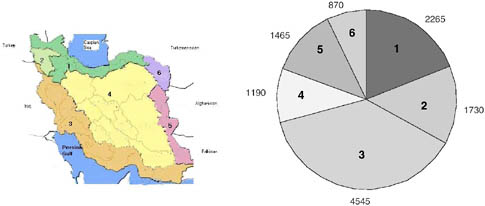
FIGURE 3 Per capita water resources (m3/year in 1994).
Figure 3 represents the uneven distribution of water in proportion to population distribution across the country. Besides the uneven distribution of population, the distribution of agricultural, industrial, and urban activities makes uneven water distribution even more important. In fact, it can be claimed that it is not only the case that water has a higher value added in certain areas as compared to others, but that the demand for water is also far higher than its supply. There are many other underlying management causes for existing water shortages such as overexploitation of groundwater resources, pollution of surface and ground water resources, low water use efficiencies in agricultural, urban, and industrial sectors, and low water productivity in agriculture as common phenomena in the country.
THE NATIONAL WATER POLICY AND STRATEGY
In the past, water resources management in Iran did not take shape on the basis of an integrated and holistic approach. The result was that the integrity of water resources and ecosystems came under serious threat. Increased awareness of the limitations of natural resources and of the role they play in sustainable development has augmented the necessity for a shift from a nonintegrated resource development approach to a holistic, sustainable, and integrated one. Among the factors raising further motivation for this shift are the increasing gap between demand and available supply, the attendant resource degradation, and the global development and application of integrated management concepts and objectives.
Some of the macropolicies and strategies adopted in 1999 by the Council on Determining the Islamic Regime’s Priorities are as follows:
-
Establishment of a comprehensive management system over the whole water cycle according to the principles of sustainable land and water development over the river basins;
-
Development of water resources within the framework of national plans and comprehensive river basin plans;
-
Integration of water resources development, exploitation, and protection plans with other national and regional plans;
-
Promotion of productivity and attention to the economic, security, and political value of water in water harvesting and extraction, supply, storage, and consumption;
-
Establishing compatibility between efficiency and social justice;
-
Promotion of public awareness, improving tariffs and ensuring their transparency.
The main objective in water management, for which the government takes primary responsibility, is the balancing and integrating of human relations with the process of water resources development, while taking into consideration criteria and guidelines for sustainable development.
The fundamental principles of water resources management based on the macropolicies of the water sector and the above-mentioned objectives of water management include:
-
Encompassing the total water cycle in water management, in which the river basin is regarded as the main element in water management structure.
-
Pursuing holistic and integrated water management, in order to establish a balance between supply and demand while taking into account the principles of sustainable development, combining structural and nonstructural measures, increasing participation of and coordinating all effective governmental and nongovernmental bodies and the various economic and social sectors.
-
Promoting productivity and preventing exploitation of the economic, security, and political value of water in its harvesting, storage, supply, and consumption. Efficiency in use must be constantly improved in the various functions of water, and the motivation for conservation and efficiency must be strengthened through such measures as education and training, as well as the application of technical and economic means.
-
Establishing formal water tariffs such that the motivation for economic uses of water is strengthened justly, and also such that the maintenance and operation costs and part of the investments in water projects are covered.
-
Increasing development of conventional and nonconventional water resources with consideration of the drawbacks and repercussions of development of resources and its effects on third parties, also seeking to minimize both natural and man-made damage. Damage and uncertainties due to economic, social, and environmental issues must be systematically calculated and included in every development proposal.
-
Coordinating land and water management within the framework of an entire watershed.
-
Coordinating between various sectors in water management.
-
Performing, planning, and decision-making on interbasin water transfer projects within an integrated and holistic management framework.
-
Establishing and strengthening local management within the water management structure (such as national water councils, river basin councils, and local water councils).
In relation to IBWT, the fundamental principles of water resources management explicitly state that, “Planning and decision-making about interbasin transfers or transfers over large distances must be made within the framework of demand management and on the basis of criteria for minimizing costs, productivity of service, and efficiency in water uses.”
According to the macropolicies and strategies in the water sector and the fundamental principles of water resources management, a comprehensive water act is in the process of development. Once this act is developed and adopted by the respective authorities, it is expected that water resource development projects, including IBWT projects, will be prepared and developed within the framework of the strategies and the fundamental principles of integrated and comprehensive water management. Nevertheless, there are many social, political, institutional, and legislative obstacles to an effective water sector reform which need realistic assessment and provisions.
INTERBASIN WATER TRANSFERS IN IRAN
Uneven water distribution and demand across the country and the shortage of water in some areas have caused water managers to consider interbasin water
transfer as a solution to these water problems. Most of these projects concentrate on the transfer of water from Regions 1 and 3 to Region 4. Table 2 presents the major interbasin water transfer projects.
Figure 4 shows the interbasin water transfer activities over the three Five-Year National Development plans (1989-2003) using the index W×L, where W is the volume of water transferred and L is the transfer length or distance.
In consideration of the fact that the two significant factors affecting costs and environmental impacts in any IBWT project are the volume of water transferred (W) and the transfer length (L), Shiklomanov (1999) proposed a combination index of WxL (Km3/year-km) to be used in the classification of IBWT projects, i.e., the product of annual transfer volume by transfer length (Shiklomanov, 1999). The classification of IBWT projects in Iran according to this index is presented in Table 3, where it is seen that most projects in Iran are either “small” or “very small.”
From among the IBWT projects implemented in Iran, descriptions on the following projects are provided in this paper: water transfer from the Karoon and Dez basins to the Zayanderud basin, Intrabasin Water Transfer to the City of Zahidan, and the Northern Iran Interbasin Water Transfer Project (Mazandaran Canal), each with its own distinctions.
TABLE 2 Key Interbasin Transfer Schemes
|
Project |
Source Basin/ Regiona |
Recipient Basin or City/Regiona |
Purposeb |
Statusc |
|
Kuhrang-1 |
Karoon(3) |
Zayanderud(4) |
A, M, I |
1954 |
|
Kuhrang-2 |
Karoon(3) |
Zayanderud(4) |
A, M, I |
1985 |
|
Kuhrang-3 |
Karoon(3) |
Zayanderud(4) |
A, M, I |
U.C. |
|
Ch. Langan |
Dez(3) |
Zayanderud(4) |
A, M, I |
U.C. |
|
Dez-Ghom |
Dez(3) |
Ghomrood(4) |
M |
U.C. |
|
Soolegan |
Karoon(3) |
Rafsanjan(4) |
A |
U.I. |
|
Halilrood |
Halilrood(4) |
Kerman(4) |
M |
U.C. |
|
Yazd |
Zayanderud(4) |
Yazd(4) |
M |
1999 |
|
Kashan |
Zayanderud(4) |
Kashan(4) |
M |
U.C. |
|
Talighan |
Sefidrud(1) |
Tehran-Ghazvin(4) |
M, A |
U.C. |
|
Lar |
Haraz (1) |
Tehran(4) |
M |
1984 |
|
Zahidan |
Hirmand(5) |
Zahidan(5) |
M |
U.C. |
|
Tabriz |
Miandoab(2) |
Tabriz(2) |
M |
1999 |
|
Moharram |
Karun(3) |
Persian Gulf Cities(3) |
M |
U.C. |
|
Chalos |
Gilan(1) |
Mazandaran(1) |
A |
U.C. |
|
Mazandaran |
Mazandaran(1) |
Golestan(1) |
A |
U.I. |
|
aRegion is shown in parentheses following each Basin or City name. bA = Agricultural, M = Municipal, I = Industrial cU.C. = Under Construction, U.I. = Under Investigation |
||||
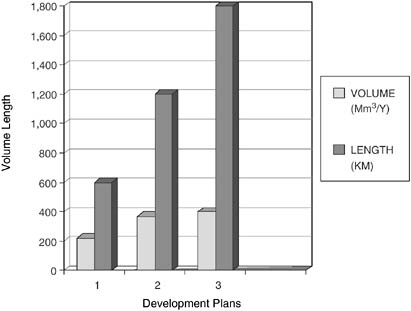
FIGURE 4 Interbasin water transfer projects over the three Five-Year Development Plans (1989-2003), measured in terms of volume of water transferred and length, or distance, of water transfer.
TABLE 3 Specification of Key IBWT Schemes
|
Project |
Length (km)a |
Volume (Mm3/y) |
Shiklomanov Categoryb |
|
Kuhrang-1 |
2.8 (T) |
300 |
V.S. |
|
Kuhrang-2 |
2.8 (T) |
160 |
V.S. |
|
Kuhrang-3 |
23.4 (T) |
260 |
V.S. |
|
Ch. Langan |
15 (T) |
200 |
V.S. |
|
Dez-Ghom |
230 (P,T) |
340 |
S. |
|
Solegan |
438(P,T) |
200 |
S. |
|
Halilrood |
95 (P,T) |
75 |
V.S. |
|
Yazd |
335 (P) |
90 |
S. |
|
Kashan |
190 (P,T) |
42 |
V.S. |
|
Tabriz |
180 (P) |
150 |
S. |
|
Zahidan |
200 (P) |
30 |
V.S. |
|
Talighan |
10 (T) |
450 |
V.S. |
|
Lar |
23(T) |
200 |
V.S. |
|
Persian Gulf Cities |
744 (P) |
182 |
M. |
|
Chaloos |
111(C) |
280 |
S. |
|
Mazandaran |
450(C) |
950 |
M. |
|
aType of infrastructure is indicated in parentheses following the length: T = Tunnel, P = Pipe, C = Canal bS= Small, V.S.= Very Small, M.= Medium |
|||
INTERBASIN WATER TRANSFERS FROM THE KAROON AND DEZ TO THE ZAYANDERUD BASIN
The Karoon and Dez basins are among the largest basins in Iran. The Karoon River has the largest discharge among the rivers in Iran and the Dez stands second to it. These two rivers stretch over a long distance to join the Arvandrood and, finally, the Persian Gulf in the south. There are several large dams on these rivers, and some more are either under construction or under study.
The Zayanderud River basin, with a total area of 41,542 km2, is located in a dry and hot zone in central Iran. The average annual precipitation in the basin is estimated to be 245 mm, which varies from 50 mm in the East to over 1,700 mm in the western tributaries. The river stretches over a distance of 355 km and passes through the historic city of Isfahan. The multipurpose Zayanderud reservoir was constructed in 1970, 110 km west of Isfahan. The river supplies water for the various agricultural, industrial, and urban needs of the areas and towns located within the Zayanderud River basin as well as several towns outside the basin. Demographically, the Zayanderud River basin hosts a rather high population and is the target of many immigrants due to its location in central Iran, the presence of major industries in the region, its fertile land, as well as its scientific, tourist, cultural, and historical attractions. Several IBWT projects transferring water from adjacent rich basins (i.e., the Karoon and the Dez) have been implemented or are under construction in order to strengthen and augment the water resources in the basin (Kuhrang Tunnels I, II, and III, and Cheshmehlangan Tunnel) (Figure 5).
Central Iran is host to the provinces of Isfahan, Yazd, Kerman, Markazi, and Qom, all of which are considered to be arid areas suffering from water shortage. The IBWT projects implemented or under construction are mainly aimed at supplying water to the major cities in the region (Figure 5). Some specifications of these projects are presented in Tables 2 and 3.
MAZADARAN CANAL PROJECT
The Province of Mazandaran is one of the northern Iranian provinces located along the coast of the Caspian Sea. Land and water studies in the region indicate that the central and western parts of the province have an excessive water supply so that a considerable volume of the water remains unused and is discharged into the Caspian Sea. Considering the limited potential for agricultural development in these areas, significant increases in future water demand seem unlikely. However, in the eastern parts of the Province of Mazandaran and in the neighboring Province of Golestan, vast areas with the potential for agricultural development have remained undeveloped as of yet, due to limitations in the water resources available. Dry farming is the prevailing practice in most of these areas. A Water Resources Survey has recently been carried out by Mahab Ghods Consulting
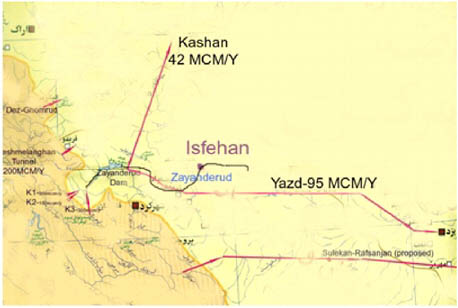
FIGURE 5 Interbasin transfers from Persian Gulf Basins to Central Basin.
Engineers in order to determine the surplus water in the western and central parts of the Province of Mazandaran that will be transferred to Eastern Mazandaran and the Province of Golestan after environmental requirements are satisfied (Mahab Ghods Consulting Engineers); The study area stretches from the eastern banks of the Aleshrood (west of the Haraz River) to the border between Iran and Turkmenistan to the east of the Caspian Sea. In the north, the study area is bounded by the Caspian Sea, and in the south it is bordered by mountains and plains (Figure 6).
The objective of the Mazandaran Canal is to collect the surplus river water along its route to be transferred for agricultural development in the Golestan Plain. Estimates of surplus water have been based on the donor area’s demand for agriculture, domestic use, industry, aquaculture development, and environmental requirements projected to the end of the planning horizon (2021). The canal in question is the continuation of another canal, currently under construction, which is intended to transfer water from the Chaloos River into Haraz Plain and to discharge the surplus water to the Mazandaran Canal (Figure 6).
According to preliminary studies, the canal length, the annual volume of water transferred, and the canal’s construction costs are estimated to be 450 km, 800-1,100 Mm3, and around 3,500 billion Rials, respectively (Mahab Ghods Consulting Engineers). The canal is planned to be an earth canal but its capacity
has not yet been determined. Due to the complexities and peculiarities of the project, it was necessary to carry out more detailed studies on all hydrological, agricultural, environmental, ecological, social, and economic aspects, which are still in progress. Planning for the project is to be accomplished using multi-criteria decision-making procedures.
Some of the issues raised in relation to this project, to be explored further in the more comprehensive study, include the following:
-
Removal of trees and the disruption of rice paddies along the route.
-
Interference with fish egg-laying habits due to reduced river flow caused by water transfer into the canal.
-
Saline water intrusion into the rivers due to reduced river flow.
-
Interference with north-south traffic in the province, especially with regard to the high population density.
-
Potential hazard to local people of drowning in the canal.
-
High costs of the project.
-
High sensitivity of the project results to the assumptions and the accuracy of the study process.
THE ZAHIDAN INTRABASIN WATER TRANSFER
The city of Zahidan, the capital of Sistan and Balouchistan Province, is one of the cities facing serious problems in terms of both quality and quantity of water. The region is characterized by a desert to semi-desert climate with long, dry, and hot summers but short, dry, and cold winters, where evaporation potential is high and precipitation is low.
Zahidan has two separate water supply systems, one supplying sanitary water (saline) and the other supplying drinking water. Currently, sanitary water for the city is supplied by an old water supply system, with which water is extracted from groundwater resources. Drinking water is supplied by a small system with public valves at several points across the city. The city of Zahidan has no wastewater collection system (it is under construction), and the wastewater is discharged into pits. The groundwater resources are thus used both for public water extraction and wastewater disposal. Population growth and the corresponding increased water extractions, along with the drought over recent years, have resulted in the decline of the water table and increased water salinity. The average electrical conductivity (EC) of the groundwater within the city is currently around 4,000 microsiemens, and in some areas it has increased up to 7,000 microsiemens. This has occurred while the biological quality of the groundwater has also deteriorated due to recharge by wastewater disposal.
The sanitary supply system is around 35 years old. Long service and the excessive salinity of the flow have weakened the system. On top of this, only 65 percent of households are covered by the water supply service. The drinking
water distribution system is very small and limited, and public valves deliver water to the people. The deficiencies of the water distribution system and the shortage of water in recent years have resulted in repeated interruptions and failures in supplying drinking water for long stretches of time. Therefore, most people obtain their drinking water from vendors who deliver water in tankers. The tankers take fresh water from a number of wells located to the west and southeast of Zahidan to distribute in the city. In addition to the health problems associated with this method of water delivery, overuse has recently caused the discharge from these wells to drop drastically. Due to the persistent water shortage, the per capita water consumption in the city has fallen from 160 liters per day in 1976 (both sanitary brackish water and fresh drinking water) to 110 liters in 2001.
To meet the city’s water demand in the coming years, a water transmission project is under implementation that will convey water from Chahnimeh Reservoir over a route of 200 km with a pumping head of 1800 m. It will carry an annual volume of 28 mm3 of water from the Sistan River (Figure 7).
The total cost of the transmitted water is estimated at 5,000 Rials per cubic meter (U.S. $1 equals 8,000 Rials). This will increase to 10,000 Rials once the costs of the construction of the new water supply system are added. This is based on the average price of one cubic meter of water in the city as being around 400 Rials, while the average in Iran is around 600 Rials.
As the commissioning and operation of the project draws nearer, certain issues are emerging that await solution. These include the method of distributing
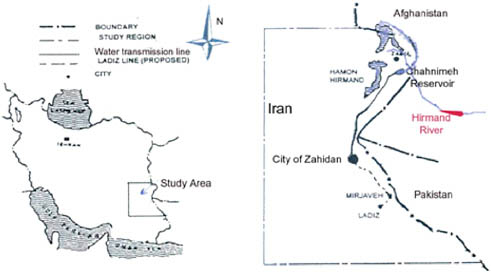
FIGURE 7 Zahidan intrabasin transfer.
water among users, and consumption patterns in the city, as well as problems arising after water is conveyed to the city (such as the expected abrupt population increase or a sudden increase in per capita consumption). It is worth mentioning that Zahidan Water & Sewage Company is in the process of designing and implementing a new water supply system to distribute the transmitted water. A per capita daily consumption of 100 liters is assumed in the design. The Company is also considering the rehabilitation and development of the two existing water supply systems. Two problems seem to arise in this system. First, the practical and possible mechanisms of controlling the per capita consumption at 100 liters/day are not clearly defined. Second, assuming a per capita consumption of 100 liters/day, the volume of water transmitted from the Chahnimeh Reservoir will not meet the urban water demands by 2011, even in the most optimistic scenarios. It is estimated that the water transmitted from the Chahnimeh Reservoir will barely suffice to meet the water demands of the city in the next 10 years. Therefore, it is essential to plan for the management of the transmitted water and the maximum use of groundwater resources. The objective in this planning must be the sustainable supply of water for the city such that the water shortage problem will be delayed to the greatest extent possible.
Planning to face these issues and problems requires comprehensive urban water management studies prior to the operation of the system under construction. The authors investigated the method of distributing the transmitted water and the existing wells, using a multicriteria decision-making method (compromise programming) (Abrishamchi et al., 2001). The general results are summarized below:
-
The results indicate that the option of bottled water deserves greater consideration in future decision-making processes. It must be emphasized that the issue definitely awaits more careful scrutiny and detailed study, especially with regards to the subsidies allocated to the water sector and its impacts on the evaluation of different alternatives.
-
In view of the sustainability criterion, future decisions must be directed toward the development and rehabilitation of the existing sanitary supply systems, construction of a drinking water supply system with public water extraction valves (at various points throughout the city but in a more systematic manner), and, finally, toward the delivery of bottled water. Indeed, the authors’ final recommendation is for more detailed investigation of the above options and the development of new alternatives accordingly.
RESULTS AND DISCUSSION
Using the assessment criteria proposed by Professor Cox (Cox, 1999) for the assessment of IBWT projects, the assessment of the interbasin water transfer projects in Iran is as follows:
Criterion 1: The receiving areas have suffered from great water shortage, but the methods of reducing demand have not been properly investigated.
Criterion 2: As the Karoon and Dez basins enjoy plenty of water, the transferred volumes make up only a small portion of the available water in these basins, and the transfers do not seem to cause any water shortages or limitations on future developments in the donor area. However, since most of the upstream tributary flows located in high mountainous areas originate from snow melts or springs, the impacts of extractions from these tributaries, however small, on the reduction of the base flow in the two Karoon and Dez Rivers may need more careful study.
Some of the IBWT projects have caused shortages in irrigation water in the donor areas. Nevertheless, the government will compensate for these losses through the implementation of solution schemes. For instance, the transfer of water from the Lar Dam to Tehran draws upon the water shares of the farmers in the Haraz Plain. The construction of the Chaloos-Babol Canal with an annual transfer capacity of 280 mm3 is expected to compensate for the water losses in the plain. The construction of the Taleghan Dam and the transfer of its water to Qazvin and Tehran will cause shortages of irrigation water in the agricultural lands downstream of Sepidrood Dam. In this case also, the government is planning for the construction of the Astoor Dam on the Ghezel Ozon River, which will contribute to a higher transfer volume from the Taleghan Dam to Tehran.
Criterion 3: No negative environmental impacts have been reported; however, a negative environmental and ecological impact is likely to occur in new projects such as the Mazandaran Canal. The possibility for such an impact is under study by the consulting engineers.
Criterion 4: No negative impacts or serious socioeconomic tensions have been reported; yet at the same time, during dry spells or dry years, objections are reported by the people in the areas of origin. The government compensates for their losses or damages through financial arrangements and compensatory schemes. In addition, water resource development schemes are also under study to supply substitute water in these areas. It also needs to be mentioned that dissatisfaction by people in donor areas is sometimes psychological and unfounded.
Criterion 5: In IBWT projects, evaluation of the benefits and the determination of fair sharing between donor and receiving areas have not been accomplished. In the absence of equitable regulations for interbasin water transfer schemes, some of the schemes have drawn heavily upon the political or power manipulation behavior of the Members of Parliament (MPs) or local water managers.
On the whole, IBWT schemes in Iran do not seem to be unacceptable options for reducing water shortages in receiving areas. However, the major defect of such schemes is that they are operated under conditions where the water consumption efficiency is still very low and the wastage of water is rather high (irrigation efficiency is around 30 percent and the urban unaccounted-for water
is next to 30 percent). In order to reduce demands, water wastage, and losses, it is essential to reconsider the application of demand management and water reuse. This is mainly because IBWT schemes are only mid-term remedies for alleviating water shortage and serve only to diminish any motivations on the part of water managers or the public to implement the more sustainable solutions of demand management. This claim is borne out by the fact that it is only during droughts that managers and the public give serious attention to reducing water consumption. Demand management is not only economically cheaper but also contributes more drastically to the sustainability of water resources and environmental pollution control.
The implementation of IBWT schemes, particularly for urban water supply, where IBWT helps to ease water crises, should not lead to the neglect of limitations of water resources in urban planning. IBWT options in alleviating urban water shortages must be employed only within holistic and integrated planning and management. The mechanisms of demand management, the different methods of urban water distribution and supply (such as the use of dual networks or bottled water), utilization of small local water resources, conjunctive use of surface and ground water and urban wastewater management, reclamation, and reuse all must be considered in the integrated management approach. Urban groundwater also must be protected both quantitatively and qualitatively for emergency conditions during which the water transfer system may temporarily fail.
RECOMMENDATIONS
The following planning strategies and principles may be recommended for consideration by managers in any water transfer scheme:
-
Only objective arguments for a water transfer scheme should be presented. Explanations must be provided for the gaps between demand and supply in the receiving region, and alternative sources for fresh water supply (especially small local sources) need to be introduced.
-
Prior to the development of any IBWT scheme, the need for water transfer should be minimized. The following measures may be used in the process of minimizing the need: (i) alternative conventional and unconventional sources of water must be considered; (ii) innovative demand management measures for water conservation and saving should be effected; (iii) by improving the operation of existing water supply systems, water supply reliability should be enhanced; and (iv) alternative schemes of water distribution and delivery in urban areas (e.g., dual networks, bottled water, and other options) must be considered.
-
The water being transferred from a basin should be surplus water after meeting all the present and future reasonable foreseeable needs of the donor basin; in other words, the present and future requirements of the donor basin must be fully met or secured.
-
Prior to the implementation of IBWT proposals, thorough assessments of social and environmental impacts must be made, as well as provision for the continuous monitoring of likely impacts during construction and operation of the projects.
-
Care must be taken to minimize adverse impacts due to water transfer both in the donor and receiving areas, as well as changes in the hydrological regimes, ecological regimes, environmental pollution, and aesthetic and human interests.
-
The decision makers and the general public need to be provided with unbiased information through professional analysis and modeling tools employed to support the IBWT multicriteria decision-making process.
ACKNOWLEDGMENTS
The authors wish to thank the U.S. and I.R. Iran Academies of Science and Sharif University of Technology for supporting this work. They would also like to thank the Environment and Water Research Center (SUT), Mr. M. Zarghaami, Mr. E. Roostazadeh, and Mrs. M. Kheirabadi for their assistance; and Mr. A. Salavitabar and Mr. A. Naghibi of Mahab Ghods Consulting Engineers, and Jamab Consulting Engineers for providing valuable information and data for this paper.
REFERENCES
Abrishamchi, A., A. Ibrahimian, and M. Tajrishy. 2001. Multi-criteria decision making in urban water management, Case study: City of Zahidan. Proceedings, 2nd Asian Conference on Water and Wastewater Management, Tehran, Iran.
Cox, W.E. 1999. Determining when interbasin water transfer is justified: Criteria for evaluation. Proceedings, International Workshop on Interbasin Water Transfer, UNESCO, Paris, April 1999. Pp. 173-178.
Jamab Consulting Engineers National Water Master Plan, Water Resources Organization of Iran, 1378 (in Farsi).
Mahab Ghods Consulting Engineers. Mazandaran Canal, Technical Report. Iran Water and Power Resources Development Company, 1380 (in Farsi).
Shiklomanov, I.A. 1999. Water transfer as one of the most important ways to eliminate water resources deficits and to solve water management problems. Proceedings, International Workshop on Interbasin Water Transfer, UNESCO, Paris, April 1999. Pp. 203-210.






















